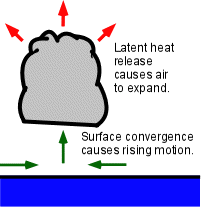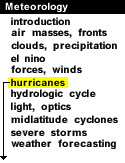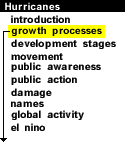
|
CISK, or "Convective Instability of the Second Kind", is a popular theory that explains how thunderstorms can evolve and organize into hurricanes. CISK is a positive feedback mechanism, meaning that once a process starts, it causes events which enhance the original process, and the whole cycle repeats itself over and over. Below is a video explanation of CISK.
| The surface air that spirals into the center of a low pressure system creates convergence (green horizontal arrows) and forces air to rise in the center (green vertical arrow). This air cools and moisture condenses which releases latent heat into the air. It is this latent heat that provides the energy to fuel these storms. |

|
Latent heat is simply heat released or absorbed by a substance (in this case, water vapor) as it changes its state. When water vapor condenses into liquid, it releases this heat into the surrounding atmosphere. The atmosphere around this condensation then warms.
Since warm air is less dense than cooler air, the warmer air takes up more space. This expansion of this air (red arrows) forces more air outside away from the center of the storm and the surface pressure (which is the weight of the air above the surface) decreases.

|
When the surface pressure decreases, a larger
pressure gradient is formed, and more air
converges towards the center of
the storm. This creates more surface convergence and causes more
warm moist surface air to rise above the surface. This air, as it
cools, condenses into clouds. While it does
this, it releases even more latent heat.
This cycle continuously repeats itself each time intensifying the storm until other factors, such as cool water, land, or high wind shear act to weaken it. |

sources |
|

Development Stages |




